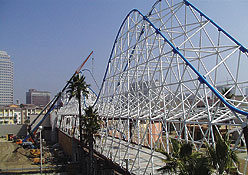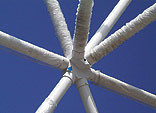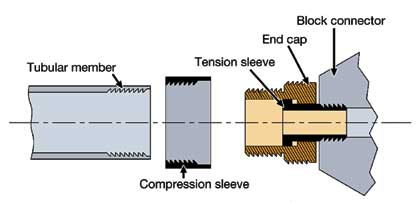 |
The superstructure lines of a newly constructed pedestrian bridge rising to 87 ft above Shoreline Drive in Long Beach, Calif., resemble the old Cyclone Racer roller coaster, a mainstay of the old neighboring Pike amusement park from 1930-68. But the aluminum space frames patented co-axial joint connections look toward the future.
The CAJ moment-resisting connection system uses no welds or bolts, says Glenn A. Reynolds, president of Gossamer Space Frames Inc. He patented the system in 1999, but the pedestrian bridge is the first field application.
 |
Circular shapes offer "the most economical, efficient, cost-effective structural members," Reynolds says. "But connections are where you lose the benefit .You have to analyze for forces as if you have a hinge."
Reynolds calls his system "invisible, requiring no tapering, welding or bolting. It fits together like a Tinker Toy."
"I was pretty scared when we took this job," says Craig Parrish, area superintendent for Phoenix-based erector Schuff Steel Co. It wasnt the roller coaster shape of a 450-ft-long set of twin bridges featuring a 150-ft clear span and 30-ft-wide concrete deck, he says. But connecting an aluminum superstructure with threaded machined connections and tying the assemblage to a steel substructure posed a challenge. "It wouldnt take much misalignment at all to make the whole thing go south," he says.
|
The erector discarded plans to assemble the superstructure off site and pick it with a crawler crane or to build it in place, piece by piece. Working with Reynolds and Gossamer bridge designer Gary Noble Curtis, Schuff engineers conceived a modular scheme. The crew assembled matching bridge sections of approximately 20x30 ft on the ground, connecting them with cross-members and continuing on. A crane lifted them into place for connection to the previously erected sections. "It took about six weeks," says Parrish. "It was pretty easy to assemble, once we got going. We actually beat the schedule."
Each tension sleeve is inserted through the end cap and screwed into a block connector, which serves as a node in traditional space frame design (see diagram). The end cap moves axially along the tension sleeve and is threaded onto the tubular member in a "reach and grab" maneuver. Finally, the compression sleeve is threaded down over the end cap and thrust against the block connector.
 |
| JOINT COMPOUND Co-axial connection ties bridg together. |
The process depends on "extremely tight machine tolerances," says Michael Harness, project manager with Snyder Langston, the Irvine, Calif.-based general contractor for the $2.5-million structure.
The aerospace industry has spawned an abundance of machine shops in the area, says Reynolds. "A tolerance of .005 on an inch is impressive in a construction environment, but in aerospace, its pretty run of the mill," he says.
Now that Gossamer has a demonstration model to show off, Reynolds is ready to tackle bigger projects. The Jet Propulsion Laboratory is interested in using CAJ on a new generation of radio telescopes. "There are a huge number of architectural opportunitiesarenas, covered walkways, glass walls, towers, atriums," says Reynolds. "Aerospace could use large jigs and fixtures. Were ready to take the next step."

Post a comment to this article
Report Abusive Comment